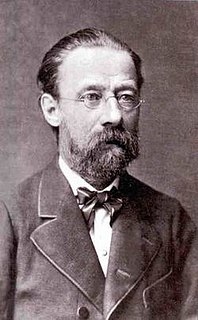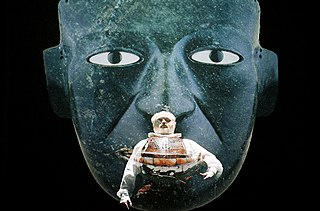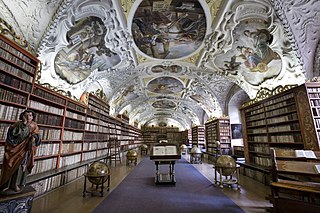
Czech literature is the literature written in the Czech language. The earliest literary works written in Czech date to the 14th century. Modern literature may be divided into the periods of national awakening in the 19th century; the avant-garde of the interwar period (1918-39); the years under Communism and the Prague Spring (1948-90); and the literature of the post-Communist Czech Republic (1992-present).
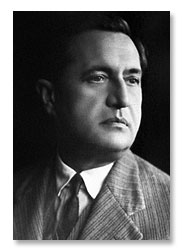
Václav Talich was a Czech conductor, violinist and pedagogue.

Josef Václav Myslbek was a Czech sculptor and medalist credited with founding the modern Czech sculpting style.

Vyšehrad is a historic fort located in the city of Prague, Czech Republic, just over 3 km southeast of Prague Castle, on the right bank of the Vltava River. It was built probably in the 10th century. Situated within the fort is the Basilica of St. Peter and St. Paul, as well as the Vyšehrad Cemetery, containing the remains of many famous people from Czech history, among them Antonín Dvořák, Bedřich Smetana, Karel Čapek, and Alphonse Mucha. It also contains Prague's oldest Rotunda of St. Martin from the 11th century.

Dvůr Králové nad Labem is a town in the Czech Republic in Hradec Králové Region, in the Labe (Elbe) river valley. It is located in the Eastern Bohemia close to the Czech highest mountains Krkonoše.
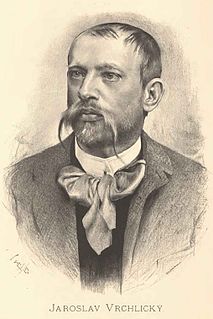
Jaroslav Vrchlický was one of the greatest Czech lyrical poets. He was nominated for the Nobel prize in literature eight times.

Vojtěch Šafařík was a Slovak chemist, specialising in inorganic chemistry. Šafařík was the son of Pavel Jozef Šafárik, a Slovak philologist and historian.

The Czech National Revival was a cultural movement which took place in the Czech lands during the 18th and 19th centuries. The purpose of this movement was to revive the Czech language, culture and national identity. The most prominent figures of the revival movement were Josef Dobrovský and Josef Jungmann.
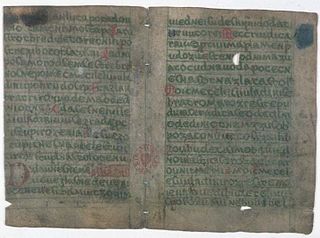
The Dvůr Králové and Zelená Hora manuscripts, also called the Queen's Court manuscript and Green mountain manuscript, are two purported medieval manuscripts of poetry in Old Czech which turned out to be literary hoaxes.

Zelená Hora is a castle on the south side of Nepomuk, in the Czech Republic. The church has been a pilgrimage site since the 1700s.
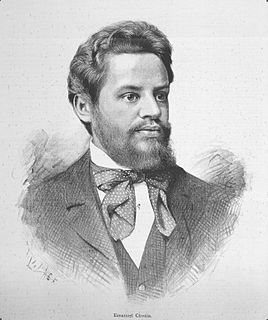
Emanuel Chvála was a Czech composer and music critic.
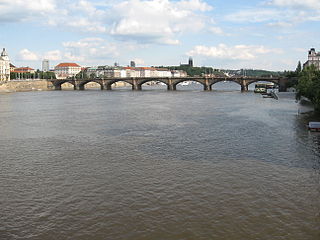
The Palacký Bridge (1876) is a bridge in Prague. It is one of the oldest functioning bridges over the Vltava in Prague after the Charles Bridge.
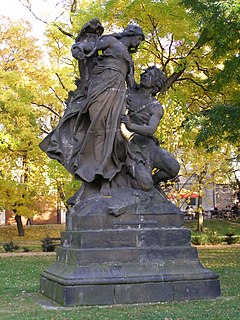
Ctirad and Šárka is an outdoor sculpture by Josef Václav Myslbek, installed at Vyšehradské sady in Vyšehrad, Prague, Czech Republic. It depicts Ctirad and Šárka of Slavic mythology and the Bohemian tale The Maidens' War, when women after the death of Libuše built the castle Děvín lying on the opposite hill of the Vyšehrad.

Záboj and Slavoj is an outdoor sculpture by Josef Václav Myslbek, installed at Vyšehradské sady in Vyšehrad, Prague, Czech Republic. It depicts the heroic brothers from the manuscripts of Dvůr Králové and of Zelená Hora. The brothers were leaders of the rebellion against invasion of the German troops of Charlemagne and allegedly led the victorious battle in 805.

Lumír and Píseň is an outdoor sculpture made by Josef Václav Myslbek in 1889-1897 for Palacký Bridge. Damaged from American bombing on February 14, 1945, statues were removed in 1948 in connection with the bridge reconstruction and installed at Vyšehradské sady in Vyšehrad, Prague, Czech Republic. The statue was previously at the New Town's side of Vltava and it was installed in the gardens with two other statues from the opposite Smíchov's side. The fourth statue, Libuše and Přemysl, was heavily damaged and repaired until reinstalled with the other three in 1977..

Libuše and Přemysl is an outdoor sculpture by Josef Václav Myslbek made in 1889-1897 for Palacký Bridge. Damaged from American bombing on February 14, 1945, bridge statues were removed in 1948 in connection with the bridge reconstruction and installed at Vyšehradské sady in Vyšehrad, Prague, Czech Republic. The statue was one at the New Town's side of Vltava and it was heavily damaged and repaired until reinstalled with the other three only in 1977. It depicts Přemysl the Ploughman and Libuše, the mythical Czech rulers settled in the 8th century at Vyšehrad.




